Elizabeth Hawes – Fashion Radical
Elizabeth Hawes (1903 – 1971) American
Elizabeth Hawes was born in New Jersey and started sewing as a teenager. In 1932, Dorothy Shaver promoted Elizabeth Hawes and a few other female designers to the media as leading American designers. Like Claire McCardell, her fashion contemporary, Hawes created simple bias-cut comfortable garments with deep armholes and natural shoulders that would be worn with flat-soled shoes. However, while McCardell’s style was somewhat suburban, Hawes was more part of the arty and sophisticated city set.
Hawes felt that the body and its clothes must work together. She thought that American women should not accept French fashion as the standard. Her goal was to bring stylish clothing with an American sensibility to the masses and believed that all women deserved to have beautiful and functional clothes.
Her career beginnings were suspect; her first job upon arriving in Paris was as a copyist for a high-end French “knock-off” copy house. She worked there for over a year eventually receiving a position in the legitimate fashion industry by apprenticing with Nicole Groult, the sister of designer Paul Poiret.
While still in Paris, she started her own fashion news service for Americans under the pseudonym “Parisite.” She also wrote columns for The New Yorker, Women’s Home Companion and PM magazine.
While considered famous in her time, she was never featured in Vogue or Harpers Bazaar because of her unconventionality which alienated fashion industry leaders. One of the reasons you may not have heard of Hawes is because of her unpopular stance on US mass production.
Hawes believed in mass production and believed that the US could learn from the French process. But the purely businesslike approach upset her and she was unwilling to make the compromises needed for American mass production. Despite this, her fashion career lasted fifteen years. After a stint working in an aviation factory during the war, she turned to studying and writing about female factory workers and the conditions they worked under.
Hollywood Connection: None, she opposed the growing idea of Hollywood being considered the capital of American fashion.
Her style, innovations, and influence on fashion:
- She is the author of nine books on fashion, the most famous ones being Fashion is Spinach (1938) and Men Can Take It (1939), which advocates for more freedom in fashion choices for men. Note: The book is available to read or download at the link above.
- She would use details such as elaborate insets of suede on her garments.
- Hawes would give her dresses unique names such as The People’s Choice, Five Year Plan, Rubicon, Alimony, and Misadventure.
- Her personal uniform consisted of a turtleneck or buttoned-down shirt underneath suspenders and deep-pocketed trousers worn with flat, flexible shoes.
Sources: Radical by Design: The Life and Style of Elizabeth Hawes (1988) Bettina Berch; Women of Fashion (1991) Valerie Steele.

 Sign In
Sign In


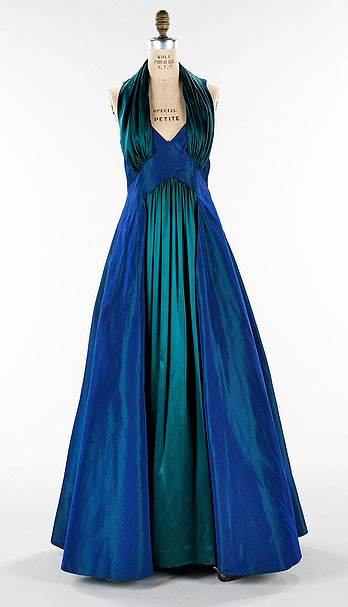

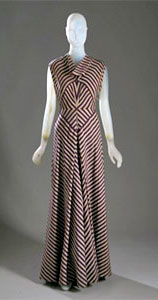
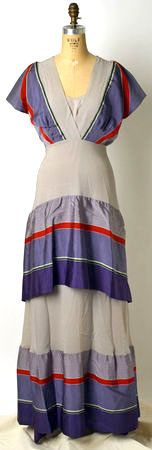
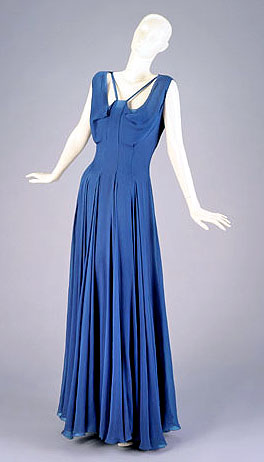

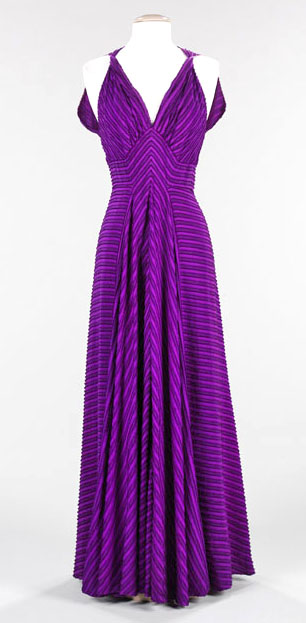

Comments
G
March 9, 2011 #
Love the stripey dress (#3). Some designs remind me of Vionnet.
Michelle Engel Bencsko
March 9, 2011 #
Beautiful gowns- and so very wearable.
Amber
March 9, 2011 #
The Diamond Horseshoe gown is stunning and very current. Thanks for a great article and a new name on my radar. ax
Louise
March 9, 2011 #
I love these especially the Styx dress!
Lindsay
March 9, 2011 #
Love this series – am learning about so many designers I’ve never heard about before. The dresses above are stunning – I particularly love the purple one.
Karen LePage
March 9, 2011 #
Thank you for bringing this champion of fashion freedom to my attention! I look forward to reading her book once I can really sit down and enjoy it.
Carolyn
March 9, 2011 #
Thank you so much for profiling this designer, I love the pieces you’ve shown! The “Styx” dress is to DIE for – I want I want I want!
Can you tell me, were these images from an exhibition? If so, could you tell me what one and was a catalogue/companion book published for it?
Thanks again!
Katherine W
January 22, 2013 #
Carolyn,
The high res images of garments are from the Brooklyn Museum Costume Collection now housed at the Costume Institute at the Metropolitan Museum of Art (images are available on the Met’s site). There is a gorgeous exhibition catalog from the exhibition that occurred after the historic transfer of the collection, which occurred simultaneously with the Costume Institute’s “American Woman: Fashioning a National Identity” exhibition. Here is the link to the BM show: http://www.brooklynmuseum.org/exhibitions/american_high_style/
Donna
March 9, 2011 #
Thanks for bringing this designer to my attention. She sounds like an interesting character and I can’t wait to read her book. The Styx gown is stunning.
melissa
March 9, 2011 #
Thanks, I’ve never heard of her but these dresses are stunning! Could you please tell me where you got the photo for the “Diamond Horseshoe” dress from? I’m hoping I can see some photos of the front, too!
Now I’m off to digest some Spinach… ;)
Meaghan
March 9, 2011 #
Hi, does anyone know who owns The Styx or what museum collection it is in?
I am so in love with Elizabeth Hawes! Her clothes are so modern for being designed in the 1930s.
Mary Beth @ Yarn U iPhone app
March 9, 2011 #
I read the Fashion is Spinach book…it’s nice to know more about the author!
lsaspacey
March 9, 2011 #
Carolyn and Melissa,
Most of these pictures come from the archives of the Costume Institute at the Metropolitan Museum of Art (use this link for more) and yes there are pictures of the Diamond Horseshoe dress from the front. That is for sure my favorite of her dresses.
lsaspacey
March 9, 2011 #
Oops, here’s the link!
http://www.metmuseum.org/works_of_art/collection_database/the_costume_institute/listview.aspx?page=1&sort=6&sortdir=asc&keyword=Elizabeth%20Hawes&fp=1&dd1=8&dd2=0&vw=0
KatyRenee
March 9, 2011 #
Thanks for introducing me to a great designer I’ve never heard of before. Love this series!
punky
March 9, 2011 #
I am now spending the entire afternoon poring over the Costume Institute collections. So beautiful! I’m loving this series, thanks for the introductions to all these wonderful designers!
Jane Schmitt
March 9, 2011 #
I just love this designer, thank you for introduction. My favorite is the Diamond Horseshoe, would love to try and make it.
raw edges studio
March 9, 2011 #
Thank you for featuring Elizabeth Hawes. I discovered her while in art school. Fashion is Spinach is a great book. It’s wonderful to see a picture of her and some of her lovely gowns.
Emma
March 9, 2011 #
Wow.. That Diamond Horseshoe. How can I describe how I feel about it, I look at it and have fallen in love. I want it to be my wedding dress. How on earth can I recreate that back effect, it’s incredible, beautiful, stunning, everything that I have ever dreamed of
Suzanne
March 10, 2011 #
Great work–thanks for the intrroduction!
Vicki
March 12, 2011 #
LOVE this. I’ve never heard her name before. Each piece is absolutely stunning! and completely timeless. I love the blue 1935 “slip and dress”. I really want to read her books based on the collection titles alone! She sounds like she was quite a character.
Vanessa
March 14, 2011 #
Love these blog posts! Thanks also for posting a link to one of her books.
Heather Louise
April 4, 2011 #
Thank you. This was an amazing post. I love the dresses and the designs. Wonderful tribute.
Mommy en France
July 8, 2011 #
How wonderful to learn about this radical and inspiring woman. I adore the dresses you’ve shown and am going to sit down quietly and read the book you linked to as soon as I can.
Katherine W
March 28, 2012 #
This is a nice post. Thought it is important to note that the images and garments belong to the Brooklyn Museum collection which is housed at the Met, not owned by…I worked with the Brooklyn Museum and have spent a lot of time with these garments. I wrote a lot of the information for the Brooklyn catalog on Hawes from my research, have presented this as a paper with the Costume Society of America and am currently working on a book about her. It’s nice to see her back on the forefront and also once again proves her designs are timeless.
Titania
January 22, 2013 #
Thanks for the delicious treat of reading this today! Lizzy was a truly amazing character, a passionate feminist and yes, aren’t her dresses wondrously modern? My husband is her son, and of course we are biased – but it is a treat to see the dresses here and the generous responses of all the readers here to them. The article is excellent. My one comment would be to question the idea that her “Hollywood Connection” is ‘none’. (Does this come from Bettina Birch? Her book is great, but I don’t recall this.) Crucially, she was married to the (later blacklisted) film director, Joseph Losey (Boy With Green Hair etc); the oldest copy of Fashion Is Spinach that we have belonged to Ernst Lubitsch; and my husband, Gavrik Losey, tells me his mother dressed Katharine Hepburn for many years,as well as Audrey Hepburn in the Moon is Blue.
Katherine W
January 22, 2013 #
Titania,
She definitely had Hollywood connections. I have research photographs in my personal files of sketches for garments that she created for Ingrid Bergman and Katharine Hepburn, in addition to various socialites including Mrs. John D. Rockefeller III. I was unaware of the Audrey Hepburn connection, but am interested in learning more for my research and to benefit the museum collection’s documentation on her. I will be presenting my work as it stands thus far at the next Costume Society of America conference in Las Vegas this spring. I would love to be in touch with you and your husband if at all possible to discuss more of Lizzy’s history. I do hope you see this reply!
Titania
January 22, 2013 #
Hi Katherine,
Yes, the Hollywood links are deep and interesting – just not as obvious as saying she did the costumes for any particular film. The Moon is Blue, with Audrey, was for theatre with Mel Ferer, I understand. It is Gavrik you will want to be in touch with. Apart from everything else, he has some superb photos of Lizzy that I have never seen on the net. She was as vulnerable, perhaps, as she was strong. It is an inspiration to find a new generation learning about her – and she deserves to be read and looked at. I guess I have seen your notes, then, on the Met site? Do you know about a wedding dress I think she designed for Narcissa Vanderbilt, that I thought the Met had? I can’t find an image anywhere, but I remember it along with the ‘obscene sweater’ with the telephone number. We don’t have twitter accounts, but if you tell us where to find you I’ll get Gavrik to email you. Nice to hear from you, T
Katherine W
January 22, 2013 #
Hi Titania,
I am thrilled to hear back from you! Yes you have seen my notes on the Met site, but only pertaining to those garments in the Brooklyn Museum collection that were transferred recently. While working at the museum on that cataloging project I became enthralled with Lizzy and her work.
I would absolutely love to speak with Gavrik and see anything he is willing to share with me.
Please have him contact me at his convenience at katherinem.hill@gmail.com
All the best!
Katherine
Titania
January 22, 2013 #
Katherine, I’ll pass on your details to him with pleasure. We have snow here tonight in the UK and he has gone to bed cold – though it’s nothing to his childhood winters in Ridgewood. It is lovely to hear of your being in thrall to Lizzy’s work and ethos; she has that effect on people sometimes. The excellent work done by Patrick Mahoney and Bettina Berch was years ago, and I know Gavrik assisted both with his letters and some recollections. It’s very exciting that you are also bringing together fresh research and focus on her now. Good luck, and watch your inbox in the next day or so. T The wedding dress, by the way, might have been for Narcissa Vanderlip (rather than Vanderbilt). We saw it at the Met on a special visit in about 1985 ! I know the Vanderlip sisters were both great friends of Lizzy from Vassar, and it seems likely that my memory is right about the dress in this case. It was extraordinary – that much I do remember. I wonder if you are also aware that Gavrik’s cousin Havilland Smith, the son of Lizzy’s fantastic elder sister Charlotte (Adams), has given his mother’s fine collection of Hawes gowns to Kent University? If you didn’t know that, be sure to look them up.
hamilton beach toaster oven set and forget
April 3, 2013 #
For this particular food you will expect butter, Dijon
mustard, ground up black pepper, skilled padding
array and also henever lower body. They’ve already superb utilized swimming pool is vital trouble-free creating food. Whenever using your own parabolic sunshine stove, remember to never fail to be dressed in Sun (uv) sterile solar shades which can be darkly not getting sun. You will definitely do not use synthetics for cleaning your own piece of equipment. You can spend a long while browsing on the web . doing your research and / or freight searching for cash flow, have the choice to perhaps save a considerable time in progressing an extra speedy program. Affected person toaster ovens, may well still considered as realistically very creative advancement.
Holly
April 20, 2013 #
When my grandmother was an eager high school senior dreaming of becoming a designer, she wrote to Elizabeth Hawes for advice on how to break into the field. I still have the letter she received in return!